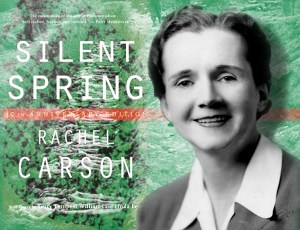 Silent Spring by Rachel Carson
Silent Spring by Rachel Carson
My rating: 5 of 5 stars
In Al Gore’s introduction to Rachel Carson’s Silent Spring he wrote, “Silent Spring came as a cry in the wilderness, a deeply felt, thoroughly researched, and brilliantly written argument that changed the course of history.
Without this book, the environmental movement might have been long delayed or never have developed at all.”

In “And No Birds Sing” Carson began making clear connections with the use of pesticides and insecticides and the hazardous effects they have on birds.
In 1954 spraying for Dutch elm disease on the Michigan State University campus began and “soon it became evident that something was wrong. Dead and dying robins began to appear on the campus” (106).
Carson went on to include other species, writing:
“Mammals, also, may easily be involved in the cycle, directly or indirectly” (110).
Direct poisoning was no longer the only act to consider in the destruction of the Earth and its species, but indirect or secondary poisoning was belonging to the threat as well.
Carson further cites research after research article which began to draw a morbid picture of how pesticides/insecticides did more harm than good in both the United States and England.
At the end of the chapter, Carson asks, “Who has made the decision that sets in motion these chains of poisonings, this ever-widening wave of death that spreads out, like ripples when a pebble is dropped into a still pond” (127)?
In “Rivers of Death” Carson continues the onslaught of scientific facts which illustrate how pesticides and insecticides not only destroy the land but how they also contaminate water supplies, indirectly poisoning human beings.
Spraying of forests led to the toxins entering into the water supply, either by rainfall or by an underground source, which then in turn poisoned the fish, and when birds and humans ate the fish, they too were poisoned.

In addition, the poisoned waters would also find their way into the drinking water, poisoning more and more humans.
The chain which linked the initial spraying of chemicals apparently did not end with the designated targets. In efforts to save trees, humanity was finding, as Carson notes, that a cycle of life was becoming broken and species were dying in the hundreds of thousands, and in some cases in the millions.
Carson ends the chapter with a warning as much as a reminder:
“The fisheries of fresh and salt water are a resource of great importance, involving the interests and the welfare of a very large number of people. That they are now seriously threatened by the chemicals entering our waters can no longer be doubted” (152).
Carson makes it clear that if one unit of the whole is contaminated then all parts of the whole, in some form or manner, also become contaminated, seriously jeopardizing everything.
Carson’s jeremiad, as Al Gore noted, “brought us back to a fundamental idea lost to an amazing degree in modern civilization: the interconnection of human beings and the natural environment. This book was a shaft of light that for the first time illuminated what is arguably the most important issue of our era.”

Silent Spring woke a sleeping nation up, and the world, angering belligerent chemical producing companies, to the deadly possibilities and truths which had long been over-looked, even blatantly ignored, in efforts to maximize profits, but in the end did more harm than good.
I recommend reading Silent Spring and more about this remarkable woman that helped to make the world a better and safer place.





















Hi to all, the contents present at this web page are really awesome for people knowledge, well, keep up the nice
work fellows.
Excellent article! We are linking to this particularly great
post on our website. Keep up the great writing.
Generally I don’t read article on blogs, but I wish to say that this write-up very compelled me to try and do so!
Your writing style has been amazed me. Thank you, very nice post.
Hmm it appears like your website ate my first comment (it was super long) so I guess I’ll just
sum it up what I wrote and say, I’m thoroughly enjoying your blog.
I too am an aspiring blog blogger but I’m still new to the whole thing.
Do you have any points for rookie blog writers?
I’d definitely appreciate it.
Wow, this post is nice, my sister is analyzing these kinds
of things, so I am going to tell her.
Good way of describing, and pleasant paragraph to take information about my presentation subject matter, which i am going to present
in university.
website (Marcella)
You really make it appear so easy together with your presentation however I to find this matter to be really one thing that
I think I’d by no means understand. It seems too complex and very large for me.
I am having a look forward to your subsequent publish, I will
attempt to get the hold of it!
Pingback: The Three-Body Problem (2006/2014) by Cixin Liu & the Remembrance of Earth's Past - CG FEWSTON